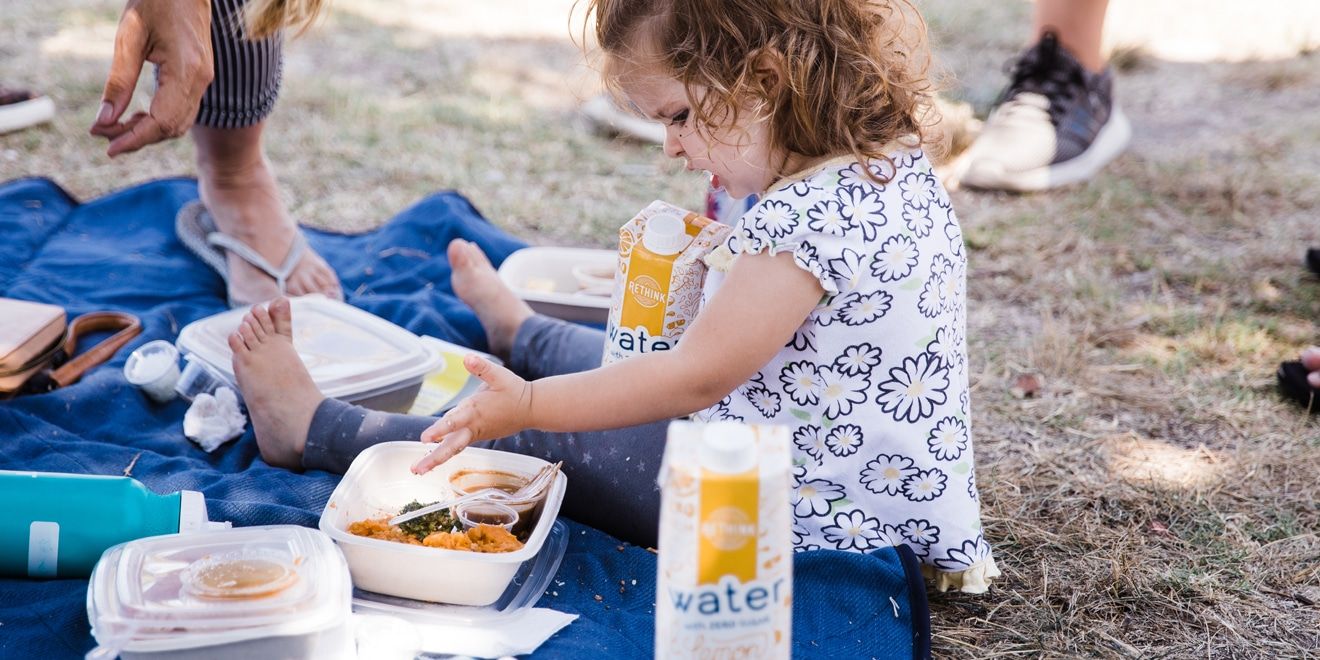Ready to introduce your kids to new foods? This is a process I understand well, when my husband and I decided to transition from a plant-based to a Whole30-inspired diet.
My first Whole30 in May of 2015 was a pescatarian Whole30. In college, I became a vegetarian because I thought it was healthier and I believed it was better for the environment. I stayed that way for about 12 years, gradually adding some seafood back into my diet during my pregnancies. In 2014 I was diagnosed with Chronic Lyme Disease, and I spent much of that year on various antibiotics and other medications as I tried to fight the disease.
I was introduced to Whole30 by my functional medicine doctor. She was trying to help my gut recover from the impact of the long-term antibiotics and felt that Whole30 would help with that as well as help with the inflammation that was contributing to many of my symptoms. While I felt amazing at the end of the 30 days, I also knew that I was relying way too much on eggs and tuna as compatible protein sources. A few months later, my husband and I did a Whole30 together, this time adding small portions of other meats such as poultry, pork and beef back onto our plates. We treated it like an experiment, and again, we felt great after the reset and decided to keep animal protein as a regular part of our daily diet.
9 Tips for Introducing Your Kids to New Foods
We had 2 kids at the time, ages 5 and 2, and neither one of them had ever tried animal protein. I knew that I didn’t want to spend the rest of my life making 2 separate meals for dinner, but I also worried that it would be traumatic (especially for my 5-year old) to introduce meat. Although our story specifically addresses introducing animal products, I’ve learned a lot over the past few years about how to help kids try new foods. Today I’ll share 9 tips from my experience in hopes it helps you when introducing your kids to new foods.
Explain the Why
My oldest had watched me struggle with Lyme Disease prior to finding that first Whole30. She was used to hearing that “mama was too tired” or “mama doesn’t feel well.” I explained to her that while I once thought it was healthier to not eat meat, my experiment with Whole30 changed my mind. She could see that I was feeling happier, healthier, and way more energetic. I told her that I wanted our family to try this new way of eating, and I asked for her help in being open to new things.
Read more tips on helping your kids find awareness around their food choices.
Alleviate Their Fears
My daughter thought it was “bad” to eat meat and that meat was “gross.” I explained (at a 5-year old level) that some meat is factory-farmed with poor conditions for animals. I explained that there were other options for responsibly-raised meat and that I would never serve her something that wasn’t up to our standards of quality and care. This is a promise that I’ve kept to this day, even when it’s difficult because the prices for these products are 3x the price of conventional. If the budget is tight, we’ll just cut back on the amount of meat that we serve with our meals.
Take it Slow
I’ll admit, we spent a couple of weeks with the kids crying at mealtime and refusing to try the animal protein. My husband and I found ourselves yelling, cajoling, and feeling generally frustrated at the end of dinner. We had to circle back and remind ourselves that there was no deadline. We were doing this because we wanted them to enjoy a wider variety of foods. Enjoy being the key word, and no one could enjoy something that was being forced into them.
Read FAQs about transitioning your kids to a Whole30-inspired diet.
Start Small
We started this experiment in January, and soup was often in our meal plan rotation. I made soups that I knew the kids liked, and just swap out chicken or beef broth instead of the veggie broth. I also added collagen to applesauce, pancakes and muffins as a taste-free way to add animal protein into their diet. (Note: I always let them know what the ingredients were, as it was our intent to have them willingly enjoy eating meat). But, if you’re just looking to get the nutrition in, these are great ways to “sneak” in some extra protein.
Add New Foods to Familiar Dishes
My kids are like most other kids I know; they love pasta. When introducing your kids to new foods, try to always have something you know they love on their plate. At first, I would make some ground beef on the side for them to add in to their pasta sauce. Once they were ok with that, I would start making a meat sauce. My kids also love “make-your-own-roll-ups” – a quick, cold dinner that I allow them to fill wraps with veggies, salsa, hummus, etc. I put out a selection of protein, (eg, pulled rotisserie chicken, strips of bacon, hard-boiled eggs). I would ask them to include at least one protein in their wrap. They LOVED being in control of what goes on their plate! This allowed them to try new flavors on their terms.
Let the Kids Help with Meal Planning
Probably the most successful tactic we took was buying a Whole30 Cookbook. Once a week, I would let them each pick one or two recipes for the family to try. They would get to explain “their” recipe to the family before the meal, and they ALWAYS tried the meal that they had chosen.
Rinse, Repeat
Five years (and one more child) into this meat-eating journey, I continue to use many of these strategies. Once the kids could eat meat sauce, I moved to meatballs. From there I could expand into meatloaf, hamburgers, tacos, etc. I could also introduce other ground meats. We now do a regular rotation of ground beef, pork, lamb, turkey, etc. We still let them “make their own” plates at least once a week. This is a great opportunity to put some new items out (prosciutto, roast beef) and see what they choose.
There is No Perfect
We’re a few years into this and there are still some items my kids won’t eat. Steak, pork chops, and anything with a chewier texture doesn’t appeal to them (or me, either, to be honest). I’ll keep serving it sporadically, and I won’t worry if they decide that it’s not for them. Also, my husband is a human seagull, so I never have to stress about leftovers or food waste.
Go Easy on Yourself
Honestly, the most difficult part of the process was admitting to my family that I may have been wrong about the way I was feeding them. But guess what? I was doing the best I could, and then I found something that worked better. I’m glad I was open to the change. This is a lesson that I want to model for my kids, and something I try to bring into other aspects of parenting.

Kate Baldacci is a mom of 3 with a passion for health and wellness. She teaches prenatal yoga classes and workshops and is a Yoga Tune Up® Level 1 Teacher. Kate has her masters in molecular biology and is drawn to programs like Whole30 and YTU® because they are based on science. Her intention is to provide clear guidance to help clients improve the way they feel and look while transforming their relationship with food..
















